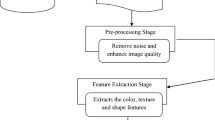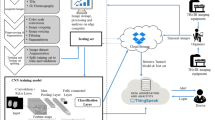Abstract
Computer assisted automatic smart pattern analysis of cancer affected pixel structure takes critical role in pre-interventional decision making for oral cancer treatment. Internet of Things (IoT) in healthcare systems is now emerging solution for modern e-healthcare system to provide high quality medical care. In this research work, we proposed a novel method which utilizes a modified vesselness measurement and a Deep Convolutional Neural Network (DCNN) to identify the oral cancer region structure in IoT based smart healthcare system. The robust vesselness filtering scheme handles noise while reserving small structures, while the CNN framework considerably improves classification accuracy by deblurring focused region of interest (ROI) through integrating with multi-dimensional information from feature vector selection step. The marked feature vector points are extracted from each connected component in the region and used as input for training the CNN. During classification, each connected part is individually analysed using the trained DCNN by considering the feature vector values that belong to its region. For a training of 1500 image dataset, an accuracy of 96.8% and sensitivity of 92% is obtained. Hence, the results of this work validate that the proposed algorithm is effective and accurate in terms of classification of oral cancer region in accurate decision making. The developed system can be used in IoT based diagnosis in health care systems, where accuracy and real time diagnosis are essential.





Similar content being viewed by others
References
Ham, B., Cho, M., and Ponce, J., Robust guided image filtering using nonconvex potentials. IEEE Trans. on Pattern Analysis & Machine Intelligence 40(1):192–207, 2018. https://doi.org/10.1109/TPAMI.2017.2669034.
Zhang, K., Wangmeng, Z., Chen, Y., Meng, D., and Zhang, L., Beyond a Gaussian Denoiser: Residual learning of deep CNN for image Denoising. IEEE Trans. on Image Processing 26(7):3142–3155, 2017.
Gupta, D., Nonsubsampled shearlet domain fusion techniques for CT–MR neurological images using improved biological inspired neural model. Biocybernetics and Biomedical Engineering 38(2):262–274, 2018.
Erfani, S. M., Rajasegarar, S., Karunasekera, S., and Leckie, C., High-dimensional and large-scale anomaly detection using a linear one-class SVM with deep learning. Pattern Recognition 58(1):121–134, 2016.
Chen, L., Papandreou, G., Kokkinos, I., Murphy, K., and Yuille, A. L., DeepLab: Semantic image segmentation with deep convolutional nets, Atrous convolution, and fully connected CRFs. IEEE Trans. on Pattern Analysis & Machine Intelligence 40(4):834–848, 2018.
Stantchev, V., Barnawi, A., Ghulam, S., Schubert, J., and Tamm, G., Smart items, fog and cloud computing as enablers of servitization in healthcare. Sensor Transducers J. 185(2):121–128, 2015.
Nandyala, C. S., and Kim, H. K., From cloud to fog and IoT-based realtime U-healthcare monitoring for smart homes and hospitals. Int. J. Smart Home 10(2):187–196, 2016.
Zhang, Y., Zheng, D., and Deng, R. H., Security and privacy in smart health: Efficient policy-hiding attribute-based access control. IEEE Internet ff Things Journal 5(3):2130–2145, 2018.
Negash, B., Et al leveraging fog computing for healthcare IoT. In fog computing in the internet of things intelligence at the edge. Cham. Switzerland: Springer 2017:145–169, 2017.
Gu, S., Xie, Q., Meng, D., Zuo, W., Feng, X., and Zhang, L., Weighted nuclear norm minimization and its applications to low level vision. Int. J. Comput. Vis. 121(2):183–208, 2017.
Ouyang, W. et al., DeepID-net: Object detection with deformable part based convolutional neural networks. IEEE Trans. on Pattern Analysis & Machine Intelligence 39(7):1320–1334, 2017.
LeCun, Y., Bengio, Y., and Hinton, G., Deep learning. Nature 521(7553):436–444, 2015.
Lopes, A. T., de Aguiar, E., De Souza, A. F., and Oliveira-Santos, T., Facial expression recognition with convolutional neural networks: Coping with few data and the training sample order. Pattern Recognition 61:610–628, 2017.
Ristin, M., Guillaumin, M., Gall, J., and Van Gool, L., Incremental learning of random forests for large-scale image classification. IEEE Trans. on Pattern Analysis & Machine Intelligence 38(3):490–503, 2016.
Liu, F., Lin, G., and Shen, C., CRF learning with CNN features for image segmentation. Pattern Recognition 48(10):2983–2992, 2015. https://doi.org/10.1016/j.patcog.2015.04.019.
Xue, W., Qiuju, X., Ma, T., and Zhu, J., Feature Extraction Based on Dimension Reduction and Clustering for Maize Leaf Spot Images. Int. J. of Pattern Recognition and Artificial Intelligence 32(12), 2018. https://doi.org/10.1142/S0218001418540290.
Jiang, Q., Yu, Y. C., Ding, X. J., Luo, Y., and Ruan, H., Bioinformatics analysis reveals significant genes and pathways to target for oral squamous cell carcinoma. Asian Pac J Cancer Prev 15(5):2273–2278, 2014.
Li, W., Jia, F., and Hu, Q., Automatic segmentation of liver tumor in CT images with deep convolutional neural networks. J. Comput. Commun. 3(11):146–151, 2015.
Jia, Y., Caffe: Convolutional Architecture for Fast Feature Embedding. 2014. arXiv:1408.5093.
Song, Y., Zhang, L., Chen, S., Ni, D., Lei, B., and Wang, T., Accurate segmentation of cervical cytoplasm and nuclei based on multiscale convolutional network and graph partitioning. IEEE Trans. Biomed. Eng. 62(10):2421–2433, 2015.
Simonyan, K., and Zisserman, A., Very deep convolutional networks for large-scale image recognition. Proc. Int. Conf. Learn. Represent., (2015), pp. 1–14.
Wang, Y., An Improved Biologically-Inspired Image Fusion Method. Int. J. of Pattern Recognition and Artificial Intelligence 32(8), 2018. https://doi.org/10.1142/S0218001417540027.
Li, Q., Medical image classification with convolutional neural network. Proc. 13th Int. Conf. Control Automat. Robot. Vis. (2014), pp. 844–848.
Jeyaraj, P. R., and Edward, R. S., Computer-assisted medical image classification for early diagnosis of oral cancer employing deep learning algorithm. J. Cancer res. Clin. Oncol., 145(4): 829-837, 2019. DOI, 2019. https://doi.org/10.1007/s00432-018-02834-7.
Zhou, Y. et al., A framework for the generation of realistic synthetic cardiac ultrasound and magnetic resonance imaging sequences from the same virtual patients. IEEE Trans. Med. Imag 37(3):741–754, 2018.
Kourou, K., Papaloukas, C., Dimitrios, I. Fotiadis., Integration of Pathway Knowledge and Dynamic Bayesian Networks for the Prediction of Oral Cancer Recurrence. IEEE Journal of Biomedical and Health Informatics, 21 (2): 320–327, 2017. DOI: https://doi.org/10.1109/JBHI.2016.2636448.
Pandia Rajan, J., and Edward Rajan, SN., Deep Boltzmann machine algorithm for accurate medical image analysis for classification of cancerous region. IET Cognitive and Comp. and syst., 1(3): 85–90, 2019. DOI: https://doi.org/10.1049/ccs.2019.0004.
Rischin, D., Ferris, R. L., and Le, Q. T., Overview of advances in head and neck cancer. J. Clinical Oncol. 33(1):3225–3226, 2015.
Acknowledgments
The Authors would like to thank the Department of Electrical Engineering, Indian Institute of Technology, Delhi and Mepco Schlenk Engineering College, Sivakasi, India for providing us the necessary facilities to carry out this research work.
Author information
Authors and Affiliations
Corresponding author
Ethics declarations
Conflict of Interest
Author J. Pandia Rajan declares that he has no conflict of interest. Author S. Edward Rajan declares that he has no conflict of interest. Author Roshan Joy Martis declares that he has no conflict of interest. Author B.K. Panigrahi declares that he has no conflict of interest. All authors declare that they have no conflicts of interest.
Ethical Approval
This article does not contain any studies with human participants or animals performed by any of the authors.
Informed Consent
Informed consent are not necessary.
Additional information
Publisher’s Note
Springer Nature remains neutral with regard to jurisdictional claims in published maps and institutional affiliations.
This article is part of the Topical Collection on Image & Signal Processing
Rights and permissions
About this article
Cite this article
Rajan, J.P., Rajan, S.E., Martis, R.J. et al. Fog Computing Employed Computer Aided Cancer Classification System Using Deep Neural Network in Internet of Things Based Healthcare System. J Med Syst 44, 34 (2020). https://doi.org/10.1007/s10916-019-1500-5
Received:
Accepted:
Published:
DOI: https://doi.org/10.1007/s10916-019-1500-5




